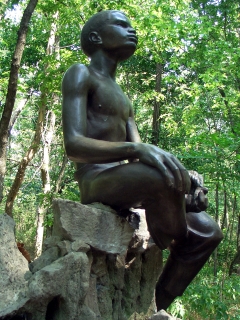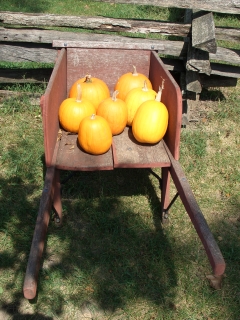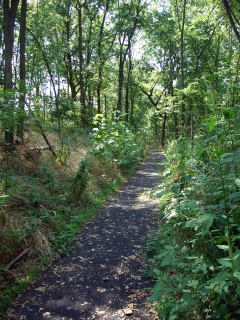George Washington Carver National Monument
Diamond, Mo.
Visited: September 1, 2005
NPS Site Visited: 245 of 353
NPS Website; Local Website
WHAT IS IT?
The birthplace and boyhood home of George Washington Carver, one of America’s greatest inventors and one of her most remarkable men.
 BEAUTY (6/10) BEAUTY (6/10)
The George Washington Carver National Monument landscape is calming, quiet and lends towards introspection. From the VC, the Carver Trail passes George’s birthplace, the ruins of a tiny cabin, and descends into the forest until reaching the remarkable Boy Carver statue. The statue portrays a young George deep in thought, his head tilted slightly towards the sky caught in a daydream, an idea and with a relaxing peace of mind.
The statue hurtles you into the Carver’s natural world, a world of necessary escape but a world of opportunity. Carver saw it as God’s world; he believed that the Creator spoke to him “through flowers, rocks, animals, plants and all other aspects of His creations”. While walking in Carver’s common, but extraordinary woodland oasis you might become one with his understanding and experience a flash of his genius.
HISTORIC SIGNIFICANCE (5/10)
How can you quantify the life of George Washington Carver? His story, his life and his absolute loving, humble Christian demeanor are so unbelievable.
Carver was born a slave in 1864 in Missouri, perhaps America’s most volatile and violent state. Shortly after his birth, Missouri bushwhackers kidnapped both him and his mother. His slave owners recovered George, at the time nearly dead from whooping cough, but never found his mother.
Carver spent his youth painting, learning about the plants and animals that surrounded him and teaching himself to read. The Carvers, formerly his owners, were illiterate and unable to assist George’s learning. He left home at eleven, moving from school to school, through sickness, extreme prejudice, violence and difficult jobs. In 1890, he found his way into Iowa State University’s agriculture program, where he would become their first African American graduate in 1894.
Carver then moved to Booker T. Washington’s Tuskegee Institute where his remarkable scientific career blossomed. Carver invented hundreds of food products, including peanut butter, and transformed the Southern farmers’ agricultural methods. By the 1920’s he had become friends with Thomas Edison and Henry Ford.
Carver died in 1943. Later that same year, FDR honored him with a National Park Site. This honor is especially remarkable when you consider that the nearby Arkansas schools did not begin desegregation until 1957 and in much of the South denied voting rights to African Americans until 1965.
CROWDS (6/10)
Just us. The Site should see waves of school group visitors any day now.
 EASE OF USE/ACCESS (3/5) EASE OF USE/ACCESS (3/5)
The Carver birthplace is located in southwestern Missouri, about 20 miles from the town of Joplin. Take Interstate 44, Exit 11 and travel south down U.S. Route 71 for 5 miles. Turn east (left) and go down Missouri Route V for about 5 miles until you reach Carver Road. Turn south (right) and signs will point you to the Park.
The NPS has resurfaced the part of the Carver Trail from the Visitor Center to the Carver Statue with an environmentally friendly material made from recycled tires. This portion of the trail is fully accessible.
CONCESSIONS/BOOKSTORE (3/5)
The store carries ten Carver biographies, five Carver children’s books and reprints of five separate Carver agricultural pamphlets. The bookstore also vends posters and Booker T. Washington biographies but the shelf entitled African American history is conspicuously bare.
African American history scholarship has flourished over the past 25 years. We should have run across a definitive collection of texts at one of the 15+ African American history-related sites we have visited. Instead, we run into bare shelves and self-help books. It does not make sense why there are more black history books at Civil War sites than at sites honoring Martin Luther King, the Brown v. Board of Education decision and George Washington Carver.
COSTS (5/5)
From the Park’s website: George Washington Carver once said, “The Lord charges nothing for knowledge and I will charge you the same.” Entry, as Mr. Carver wanted, is free. Free Ranger-led tours of the Site leave twice a day.
RANGER/GUIDE TO TOURIST RATIO (3/5)
We had a personal Ranger tour albeit a rushed tour since she needed to get back to the Museum in order to give another Ranger a lunch break. The Carver Discovery Center was closed.
TOURS/CLASSES (5/10)
None of the Site’s educational offerings, the 40-year old film, the Mission ’66-era Museum and the rushed Ranger tour, was particularly compelling. The interactive Carver Discovery Center was closed during our visit and, although aimed at children, could have been fun.
In retrospect, we should have wandered both the Carver Trail and the Contemplative Loop Trail on our own, sans Ranger. Rocks bearing meditative GW Carver quotes appear during the entire journey giving an insight into his tremendous life. The Park’s trees, insects, animals, birds, ponds and pathways were Carver’s education. Nature was his personal teacher; we must learn to make it ours.
 FUN (5/10) FUN (5/10)
Carver NM is Part One of the saga. George’s boyhood, while amazing, is the least interesting part of his story. The agricultural discoveries at Tuskegee, his aristocratic friendships and even his determined post-Missouri educational path are all more appealing than his boyhood. George left here at eleven and never again called it his home.
Touring the Carvers’ house also elicits odd emotions which we cannot come to grips with. The fact remains that they owned George in 1864 Missouri, two years after the issuing of the Emancipation Proclamation. Missouri remained a slave state until the War’s end because it was pro-Union. How is that for irony? George never wrote about the situation with any animosity or mixed feelings, only thanks and appreciation, so why should we feel differently?
It is no wonder that rural Missouri life 150 years ago spawned the complicated race-probing writings of the greatest American author: Mark Twain.
WOULD WE RECOMMEND? (4/10)
We enjoyed the George Washington Carver Museum at the Tuskegee Institute much more. Nonetheless, if you are driving westward down I-44, the path of the classic American road, Route 66, then a quick stop to Carver’s birthplace is in order. It could be the last eastern woodland-forested landscape your cross-country trip will see.
TOTAL 45/80
|